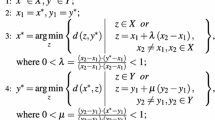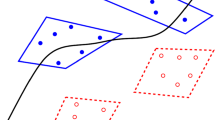Abstract
Support Vector Machine (SVM) has become a very effective method in statistical machine learning and it has proved that training SMV is to solve Nearest Point pair Problem (NPP) between two disjoint closed convex sets. Later Keerthi pointed out that it is difficult to apply classical excellent geometric algorithms direcly to SVM and so designed a new geometric algorithm for SVM. In this article, a new algorithm for geometrically solving SVM, Kernel Projection Algorithm, is presented based on the theorem on fixed-points of projection mapping. This new algorithm makes it easy to apply classical geometric algorithms to solving SVM and is more understandable than Keerthi’s. Experiments show that the new algorithm can also handle large-scale SVM problems. Geometric algorithms for SVM, such as Keerthi’s algorithm, require that two closed convex sets be disjoint and otherwise the algorithms are meaningless. In this article, this requirement will be guaranteed in theory by using the theoretic result on universal kernel functions.
Similar content being viewed by others
Explore related subjects
Discover the latest articles, news and stories from top researchers in related subjects.References
Vapnik V. Statistical Learning Theory. Addison-Wiley, 1998.
Bennett R, Bredensteiner E J. Geometry in Learning. Tech. Report, Department of Mathematical Sciences, Rennselaer Polytechnic Institutes, New York, 1996.
Keerthi S S, Shevade S K, Bhattacharyya Cet al. A fast iterative nearest point algorithm for support vector machine classifier desing.IEE Transactions on Neural Networks, 2000, 11(1): 124–136.
Crisp D J, Burges C J C A geometric interpretation of μ-SVM classifiers.NIPS 12, 2000, pp. 244–250.
Tao Qing, Sun Dermin, Fan Jinsong. The maximal margin linear classifier based on the contraction of the closed convex hull. To appear inJournal of Software.
Llanas B, de Sevilla M F. An interative algorithm for finding a nearest pair of points in two convex subsets ofR n.Computers and Mathematics with Applications, 2000, 40: 971–983.
Platt J Fast training of support vector machines using sequential minimal optimization in Advances in Kernel Methods—Support Vector Learning. Scholkopf B, Burges C J C, Smola A J (eds.), Cambridge, MA: MIT Press, 1999, pp.185–208.
Gilbert E G Minimizing the quadratic form on a convex set.SIAM J. Contr., 1966, 4: 61–79.
Mitchell B F, Dem’yanov V F, Malozemov V N. Finding the point of a polyhedron closest to the origin.SIAM J. Contr., 1974, 12: 19–26.
Gilbert E G, Johnson D W, Keerthi S S. A fast procedure computing the distance between complex objects in three dimension space.IEEE J. Robot. Automat., 1988, 4: 193–203.
Muller K Ret al. An introduction to kernel-based learning algorithms.IEEE Trans. Neural Networks, 2001, 12(2): 181–201.
Tao Qing, Wu Gaowei, Wang Jue. The theoretical analysis of kernel technique and kernel covering approach. Technique Report, Institute of Automation, Chinese Academy of Sciences, 2001.
Tao Qing, Wang Jiaqi, Wang Jue. Soft kernel projection algorithm for support vector machines. Technique Report, Institute of Automation, Chinese Academy of Sciences, 2001.
Author information
Authors and Affiliations
Corresponding author
Additional information
This research is supported by the NKBRSF of China (Grant No. G1998030508), the National Natural Science Foundation of in China (Grant No. 60175032) and the Pilot Program of the Knowledge Innovation Project of Chinese Academy of Sciences.
WANG Jiaqi received his B.S. degree from Beijing Polytechnic University in 1998. He is currently a graduate student in Institute of Automation, Chinese Academy of Sciences, P.R. China. His research interests are data mining, machine learning and kernel method.
TAO Qing received the M.S. degree in mathematics from Southwest Normal University in 1989 and the Ph.D. degree from the University of Science and Technology of China in 1999. From June 1999 to June 2001, he was a Postdoctoral Fellow in the University of Science and Technology of China. He is currently a Postdoctoral Fellow in Institute of Automation, Chinese Academy of Sciences. His research interests are neural networks, nonlinear function analysis and SVM theory.
WANG Jue is a professor in Institute of Automation, Chinese Academy of Science. His research interests are ANN, GA, multi-agent system, machine learning and data mining.
Rights and permissions
About this article
Cite this article
Wang, J., Tao, Q. & Wang, J. Kernel projection algorithm for large-scale SVM problems. J. Comput. Sci. & Technol. 17, 556–564 (2002). https://doi.org/10.1007/BF02948824
Received:
Revised:
Issue Date:
DOI: https://doi.org/10.1007/BF02948824




